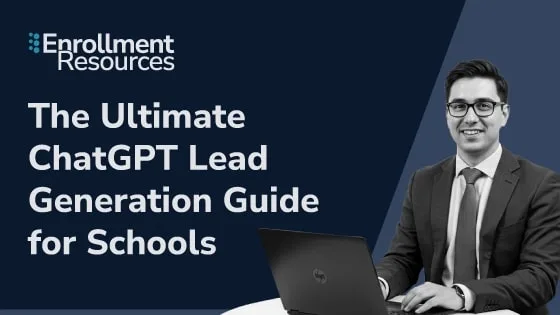
In this step‑by‑step ChatGPT lead generation guide, schools will learn how to turn AI tools into high‑intent inbound leads with faster sales cycles.
Prospective students aren’t just Googling anymore, they’re leveraging AI tools like ChatGPT to ask questions, compare programs, and get personalized advice. And unlike traditional search traffic, these AI-assisted leads are highly targeted, and ready to convert.
At Enrollment Resources, we’ve seen firsthand that leads coming through AI touchpoints are more likely to close, often with shorter sales cycles. Students have grown to place real trust in these tools, and the schools that adapt fast will win.
Why AI-Generated Leads Are Outperforming Traditional Digital Channels
- Higher Intent: Students ask AI tools pointed, decision-stage questions, and AI tools can deliver tailored recommendations by drawing on the student’s full conversation history.
- Shorter Funnel: With personalized answers and instant support, students are skipping multiple steps in the decision-making process.
- Higher Trust Factor: AI is perceived as neutral and informative, students are more open and honest with it than with traditional ads or websites.
From SEO to AEO & GEO: How the Lead Generation Playbook Is Changing
Traditionally, schools have focused on SEO, ranking their website content on Google. But now, to get noticed by tools like ChatGPT and other AI interfaces, they need to optimize for:
- SEO (Search Engine Optimization): Still critical for getting your content discovered and indexed, forming the foundation for effective AEO and GEO.
- AEO (Answer Engine Optimization): Ensuring your school is the “answer” AI tools, such as ChatGPT, surface in response to direct student questions.
- GEO (Generative Engine Optimization): Crafting content and data structures that AI tools, like Google’s AI Overview, can interpret, reframe, and reference accurately.
AEO Best Practices: How to Get Your School Featured in ChatGPT Responses
To win visibility in AI tools like ChatGPT, your blog and website content must be structured with AI-readability in mind. Here are seven practical tips to optimize your blog and website for maximum visibility:
- Think Like a Prospective Student
Use intent-driven, natural-language questions as headers (e.g., “What trade school programs lead to the highest-paying jobs?”). Write how students would actually ask ChatGPT questions. - Structure for Easy Extraction
Similar to SEO best practices, break content into clear sections with H2/H3s. Use bullet points, bold key takeaways, and start answers immediately under the question. - Include a TL;DR or FAQ Section
Add a “Quick Answer” or summary at the top or bottom, AI tools often pull directly from these for responses. - Write Simply and Conversationally
Aim for an 8th-grade reading level. Use clear, accessible language and avoid jargon unless defined. - Go Deep and Stay Relevant
Cover the topic thoroughly, link to related pages, and show subject expertise. AI values substance and domain authority over keyword repetition. - Make Attribution Easy
Mention your school or company name within the content. For example: “At Oakwood College, we’ve seen…” This helps AI cite you as a source. - Keep Your Content Fresh
Update blogs every 3–6 months with new data or FAQs. AI tools prioritize recently maintained, accurate content.
Winning with GEO: Help AI Tell Your Story
AI doesn’t just index, it generates. Give it the right building blocks:
- Highlight unique student motivations, outcomes, and success stories.
- Use clear, consistent branding and messaging across platforms.
- Create assets (like blogs, testimonials, or program guides) that AI can synthesize into helpful answers.
Schools That Adapt Will Lead the Pack
In the age of AI, it’s not just about being found, it’s about being chosen. The schools showing up in ChatGPT responses and other AI-generated answers are the ones that will fill their classes faster.
Ready to Win High-Intent Leads from AI?
We help schools like yours turn AI and website tools into real, trackable enrollment results.
